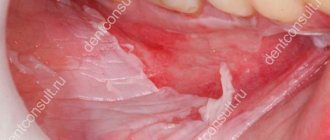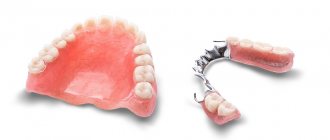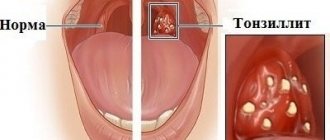Types of rashes
Depending on the disease that causes the rash, the ulcers will differ in color, pain, size, and area of coverage of the tongue. Sometimes they can spread to the gums, throat, lips. If the ulcers are of a fungal nature, then swelling is observed, mucus may appear, and pain when pressed. If the pathology is caused by viral infections, low-grade fever and enlarged lymph nodes are observed.
- Ulcers on the tongue and throat are white. Most often they are not painful. If you try to squeeze out such a formation, pus or ichor may appear. In rare cases, pain is observed when pressing on the abscess. If there is also a white coating with a cheesy consistency, the cause of the pathology is candidal stomatitis. This disease is quite easy to treat and after a course of treatment does not bother the patient.
- Red blisters with purulent contents on the tongue. This may be a manifestation of an allergic reaction or a malfunction of the endocrine glands. Sometimes such rashes indicate chronic diseases of the gastrointestinal tract.
- Transparent blisters filled with pus on the surface of the tongue. This may indicate a herpes infection. This is a viral disease, the exacerbation of which most often begins with weak immunity, colds, hypothermia, and chronic stress. Most often, short therapy with drugs such as Acyclovir helps.
- Abscess under the tongue. It may appear one or more. If this abscess increases in size and hurts, it is a boil. Treatment of furunculosis on the mucous membranes requires medical intervention. Most often, surgical dissection of the abscess is performed with removal of the rod, since the boil itself will not go away.
- White dots on the tongue with purulent contents may indicate lichen, damage to the mucous membrane by certain fungi, impaired bile flow, chronic intestinal and liver diseases. Most often, such rashes do not bring any pain to their owner. To definitely determine the cause of such ulcers on the tongue, you should undergo a full examination of the body. After eliminating the pathology of the internal organs and strengthening the immune system, the problem will disappear by itself.
Characteristic symptoms
The pathology is characterized by a fairly rapid pace of development. Based on where exactly the neoplasm is localized, experts distinguish between deep and superficial forms of abscess. Let's look at each of them in more detail.
Surface view
In this case, an abscess occurs on the back of the organ. The person experiences acute pain during swallowing, which often radiates to the ear. As part of a visual examination, noticeable swelling of the mucous membrane can be detected; when touched, a compaction can be clearly felt. Such an abscess can open without outside help, but in any case professional treatment is necessary.
Deep view
This is a more dangerous form of pathology, in which purulent processes develop in the thickness of the tissues of the organ. Experts include the following conditions as associated symptoms:
- general weakness,
- poor appetite
- restless sleep due to constant painful sensations,
- tachycardia,
- heat,
- enlarged lymph nodes,
- increased salivation,
- severe swelling of the organ, acute pain,
- blue mucous membranes, formation of gray plaque,
- the appearance of bad breath.
The main danger is that when an abscess develops, the tongue greatly increases in size. As a result, problems arise not only with speech, but also with breathing.
Reasons why ulcers and ulcers form
A list of reasons why ulcers may appear on the root of the tongue, under it, on the mucous membrane of the mouth, gums, and throat:
- Decreased immunity. Candida stomatitis, herpes, fungal plaque and ulcers appear. This process is almost always accompanied by decreased performance, chronic fatigue, and lack of vitality. The patient appears lethargic and depressed. First, you should undergo therapy with antifungal drugs, and, if necessary, antiviral drugs. Then, improve your immunity, establish proper nutrition, avoid overwork at work and physical fatigue, and take a course of immunomodulator drugs.
- Violation of the integrity of the mucous membrane. This occurs if the patient cuts or bites the tip of the tongue. If pathogenic bacteria enter the wound, a purulent formation develops. This is a common cause of ulcers on the tongue. For example, the patient ate seeds, and a piece of the peel got into the wound or under the mucous membrane. This may cause the formation of a boil or abscess. A large abscess under the tongue often forms precisely because of wounds and food particles getting into them. Another common phenomenon is injury to the cheek from the inside, which is subsequently accompanied by suppuration.
- Deviations in the functioning of organs and systems of the gastrointestinal tract are often the causes of ulcers on the tongue. In this case, the rashes are painless, almost no ichor is released from them, but a plaque appears, as with candidal stomatitis. The tongue may be coated. Most often, after treating the problematic organ, the problem with rashes on the tongue goes away on its own without the use of any local treatment.
Features of a purulent abscess
An abscess on the oral mucosa is a kind of abscess, which is characterized by severe inflammation and the formation of purulent masses. Gradually, it leads to the death of living tissue, and in an advanced stage it is accompanied by a general deterioration in the patient’s condition and the appearance of severe pain during talking, chewing food and even breathing. Obviously, this pathology can provoke very serious consequences for the body as a whole, so under no circumstances should an abscess in the oral cavity be ignored.
The photo shows a tongue abscess
An abscess of the root of the tongue, as, in fact, of any other part of this organ, is quite readily treatable, but requires an integrated approach to solving the problem. It is important to understand here that the sooner inflammation is detected, the easier and faster it can be eliminated. The pathology in question has a serious impact on the overall health and immunity, so do not hesitate with treatment.
Modern diagnostic methods
Most often, doctors use the following diagnostic methods:
- Scraping to determine the type of pathogenic microorganism.
- Taking venous blood to obtain information about the functioning of the liver, the presence of inflammatory and infectious processes in the body.
- Taking blood from a finger to determine your sugar level.
- A smear to detect certain sexually transmitted diseases (if they exist).
If you suspect any serious pathologies in the body, it is often necessary to conduct an MRI, CT scan, or x-ray. If ulcers on the tongue are a consequence of a violation of the outflow of bile, polyps and other neoplasms in the intestines or fatty degeneration of the liver, long-term and serious treatment is necessary.
Aphthous stomatitis: symptoms and treatment
This is one of the most common diseases that causes ulcers on the tongue. Aphthous stomatitis is a type of common inflammation of the oral mucosa, accompanied by the appearance of rashes. Very often, ulcers affect not only the surface of the tongue, but also the inner surface of the cheeks, palate, gums, and the surface of the throat. An exacerbation of the disease most often occurs during a period when the patient’s immunity is reduced. This process is almost always accompanied by decreased performance, chronic fatigue, and lack of vitality. The patient becomes indifferent and depressed.
Treatment of aphthous stomatitis is carried out in the following ways:
- Taking antifungal drugs.
- In some cases, antiviral medications are prescribed.
- Rinsing your mouth with medicinal decoctions.
- Mandatory use of immunomodulators for prevention purposes.
It is possible to completely cure acute aphthous stomatitis, but not its chronic form. A long period of remission and a decrease in the intensity of symptoms will be considered a success in therapy. Treatment should be carried out only with an integrated approach. This includes mouth rinsing, taking various medications (the name and dosage are reported by the treating dermatologist or infectious disease specialist), and essential preventive measures. The main one is increasing immunity to avoid relapses of the disease.
Other types of stomatitis
Stomatitis can be treated by a dentist, dermatologist, or infectious disease specialist. This is a lesion of the mucous membrane of the mouth, tongue and gums, which develops most often due to infectious processes in the oral cavity. To relieve symptoms, a comprehensive therapeutic intervention is necessary.
How to treat an abscess on the tongue if it is caused by stomatitis? First you need to make sure that the diagnosis is correct. Stomatitis is most often characterized by a scattering of small ulcers on the side and top of the tongue. The bottom of the tongue almost always remains clean.
Antiseptic solutions for mouth rinsing are used for treatment. Chlorhexidine has good reviews. It is acceptable to use folk remedies - decoctions and infusions of herbs that contain tannins and anti-inflammatory substances. These are chamomile, oak bark, celandine and others. In some cases, it is necessary to take antiviral or antibacterial agents.
Syphilis is the cause of the appearance of ulcers on the tongue
Almost all patients consider syphilis a disease that manifests itself only on the surface of the genital organs. It's a delusion. There is a type of syphilis that is located in the oral cavity. White ulcers on the tongue are one of the main symptoms of this disease.
The reasons for its appearance may be:
- The patient visited a dentist, who performed treatment without disinfecting the instruments.
- A special risk group is doctors and nurses who are constantly in contact with sick people and can easily become infected themselves.
- Transmission through household means - through shared utensils, toothbrushes.
- Injury to the mucous membrane if Treponema pallidum, which causes syphilis, gets into the wound.
To treat this oral disease, bactericidal drugs are most often prescribed. To prevent the disease from continuing to spread, treatment should be started immediately.
Tongue abscess: Causes
Most often, the problem occurs after a small wound on the tongue becomes infected with staphylococcal and streptococcal bacteria. Damage to the surface of the tongue can be caused by constantly rubbing dentures, sharp edges of unhealthy teeth, or a prick from a fish bone. Possible cross-infection of the tongue due to purulent inflammation of the gums on the inside of the teeth. This pathology can be a complication of glossitis (mild inflammation of the tongue), ulcerative stomatitis (inflammation of the mucous tissues of the oral cavity), and sometimes acute tonsillitis (inflammation of the tonsils). The nature of inflammation and its spread are determined by the peculiar structure of the tongue. Thus, damage to one lobe of the tongue never spreads to the opposite side. The most dangerous is the location of the purulent capsule at the root of the tongue (due to the proximity of the lymph nodes).
Thermal damage to the mucosa
Each of us has at least once been burned by hot coffee, tea, or first courses. For a burn, a temperature of about ninety degrees is enough. This is not boiling water, but a liquid that has not cooled down enough. Also, burns to the oral cavity often occur when eating hot solid food.
Due to thermal damage to the mucosa, you can get a second degree burn. This will be expressed in the appearance of a painful blister on the second or third day after the injury. From the inside it will be filled with ichor and pus. It is forbidden to pierce or influence it in any way. After a few days, the pain will subside and the blister will go away on its own. To reduce pain and itching, you can rinse your mouth with infusions of herbs - oak bark, chamomile, and saline solution.
Methods for treating inflammation and abscesses on the tongue
The most common causes of ulcers on the tongue were described above. Treatment can have several directions:
- Boost immunity to prevent recurrence of rashes.
- Taking pills to stop the current inflammatory or fungal process in the body.
- Rinsing the mouth with bactericidal compounds or healing infusions to relieve the patient of pain and itching.
Only a dentist or dermatologist can tell you the exact name of the drugs and the required dosage after establishing an accurate diagnosis.
How to treat ulcers on a child’s tongue? Many drugs that are permitted for adults are prohibited for children. They are more likely to develop side effects from taking the pills. For children, bactericidal rinsing solutions or mild antibacterial drugs with a minimum of side effects are more often used.
Treatment methods at home
Treating ulcers on the tongue at home is not a very complicated process. There are many traditional medicine recipes that are as effective as pharmaceutical medicines.
- Olive oil is an excellent healing component that will help restore the integrity of the mucous membrane. A simple recipe for ulcers on the tongue: mix a teaspoon of olive oil, the same amount of honey and one egg white. Apply with a cotton swab to the affected area of the mucous membrane. Relieves symptoms of pain, itching, has nourishing and moisturizing properties.
- Potato juice is also useful for purulent lesions on the surface of the tongue. A small potato tuber should be peeled, then grated on a fine grater. Squeeze the resulting mass and add a teaspoon of olive oil. You can apply compresses to the tongue. In this case, it must be protruded from the mouth during the procedure.
- Crushed burdock root can be used for treatment both fresh and dry. This wonderful plant has the ability to heal, restore mucous membranes and disinfect the oral cavity. To obtain a decoction, you need to boil a tablespoon of burdock root in 200 grams of water for ten minutes. Rinse your mouth several times a day. You can add aloe juice or raw potato; this multi-component infusion should be used immediately, as it quickly loses its medicinal properties.
Prognosis and prevention
The success of treatment largely depends on how deeply the infection has spread and how quickly the person receives medical care. If an abscess is diagnosed in a timely manner, the likelihood of a favorable outcome will be at the highest level - the disease can be cured in just a couple of weeks. If the problem is neglected, the situation may result in the development of phlegmon and sepsis. To prevent the appearance of an abscess on the tongue, including relapses, it is enough to follow the recommendations of doctors:
- pay close attention to oral hygiene, brush your teeth and tongue twice a day,
- minimize the consumption of too spicy and salty foods,
- take care of the condition of the oral cavity, try not to injure the mucous membrane with foreign objects,
- in case of accidental damage, you should thoroughly rinse your mouth with water and an antiseptic solution, and also, just in case, consult a specialist to eliminate the risk of infection of the wound,
- strengthen the immune system - a healthy lifestyle, frequent walks in the fresh air, sports and proper nutrition,
- systematically visit the dentist for preventative care.
Preventive examinations with a dentist will help you avoid problems.
If you detect any suspicious changes in the condition or appearance of the oral cavity, you should definitely consult a doctor for advice. It is better to waste your time and go to a specialist than to undergo long and grueling treatment.
Aloe and bee products for ulcers on the tongue
Bee products and aloe juice have long been famous for their healing properties in the treatment of oral diseases.
- Honey and bee products are famous for their anti-inflammatory effects. In order for honey to have a beneficial effect on the surface of the tongue, you should hold a teaspoon with a thick natural component in your mouth for five minutes. Honeycombs are also good in this regard. You should roll them in your mouth until completely dissolved. During this process, they additionally massage the gums.
- Aloe vera has long been famous for its healing properties. You should pick a few fleshy leaves and grind them in a blender. Apply the resulting mass to the tongue area. You should not swallow this remedy, as aloe juice can cause digestive upset. You can also rinse: take a teaspoon of aloe juice and the same amount of fine salt per glass of water. Rinse not only your tongue, but the entire oral cavity.
Home remedies
To speed up the wound healing process after treatment, you can resort to proven home methods. Here it should immediately be noted that their use is justified only if the attending physician has given his consent. Here are some reliable tips:
- rinsing with a light saline solution at the rate of 2 teaspoons per glass of water at room temperature,
- treating wounds with a solution of hydrogen peroxide or Chlorhexidine,
- applying a piece of ice to relieve acute inflammation.
Tongue abscess is a disease that is inevitably accompanied by very unpleasant symptoms. A general deterioration in health, high temperature, pain, problems with speech and breathing are only a small part of what the development of such a serious and dangerous phenomenon in an advanced stage entails. To prevent the situation from worsening, consult a doctor immediately when the first signs of pathology appear.
- Vernadsky Yu.I. Fundamentals of maxillofacial surgery and surgical dentistry, 2003.











